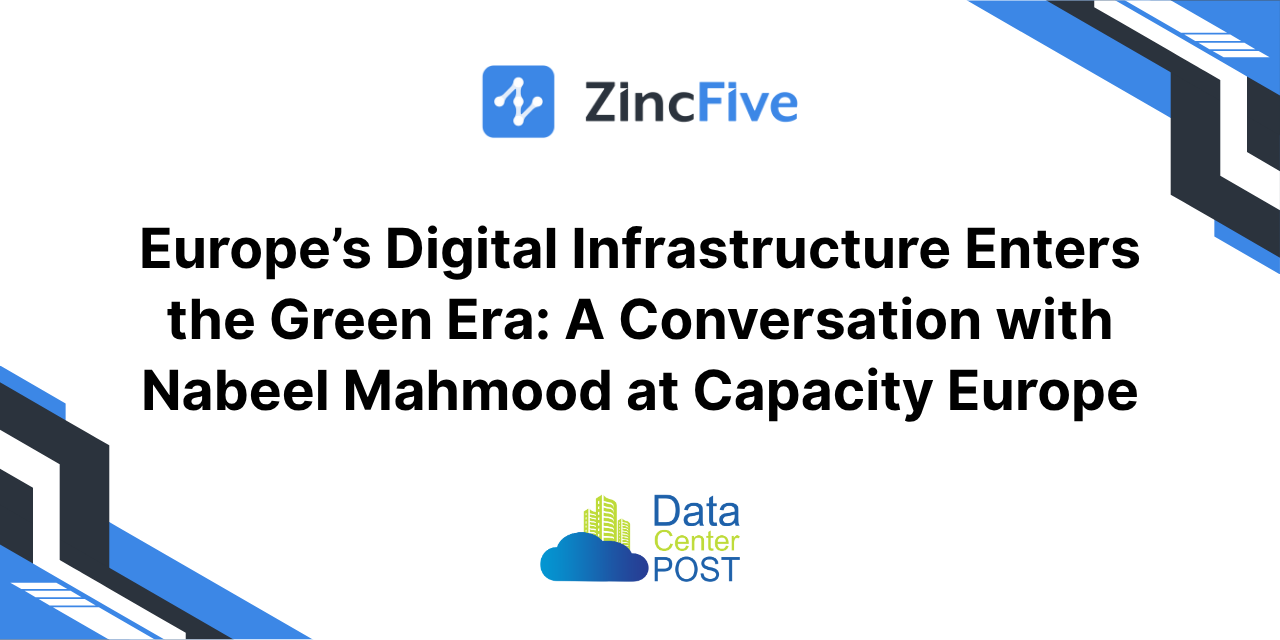Interview: Jayne Mansfield, ZincFive, with Nabeel Mahmood, Mahmood
At this year’s Capacity Europe conference in London – the epicenter for conversations shaping the digital infrastructure landscape – one theme cut through every panel and hallway exchange: Europe’s data future must be both powerful and sustainable.
To unpack what that really means for investors, operators, and policymakers, we sat down with technology executive and Top 10 Global Influencer Nabeel Mahmood, who spoke at the event about the region’s evolving data-center ecosystem.
“Demand is exploding across the UK and Europe,” Mahmood told us. “AI, edge compute, high-density GPU workloads, and hyperscale cloud deployments are all converging – and they’re forcing a rethink of what infrastructure looks like.”
The Shift from Scale to Strategy
Mahmood’s central message was that the market’s priorities are shifting from ‘how much’ capacity to ‘how and where’ it’s built. Across the region, sustainability and energy resilience are no longer nice-to-have checkboxes; they’re becoming the foundation of investment decisions.
“Infrastructure used to be a race for megawatts,” he explained. “Now it’s a race for smarter, greener, and more sustainable megawatts.”
That shift is already visible in the UK, where annual data-center investment is projected to soar from roughly £1.75 billion in 2024 to £10 billion by 2029. While London remains dominant, new projects are spreading beyond the M25 as developers chase available power and faster permitting timelines.
Mahmood pointed out that “the UK’s declaration of data centers as critical national infrastructure is a step in the right direction – it signals recognition that digital infrastructure underpins everything from jobs to national competitiveness.”
Europe’s Tightrope: Power, Land, and Policy
Across continental Europe, the picture is similar but more constrained. The so-called FLAP-D markets – Frankfurt, London, Amsterdam, Paris, and Dublin – are nearing record-low vacancy rates, with take-up expected to hit 855 MW in 2025, up 22 % year-on-year.
“Grid capacity and land availability have become the new bottlenecks,” Mahmood said. “Those constraints are pushing investors to look at secondary markets – Milan, Nordic hubs, even parts of Southern Europe – where renewable energy integration and policy agility are improving.”
That migration is reshaping the map of European data infrastructure, with sustainability as the common denominator. Operators are incorporating liquid cooling, renewable sourcing, and battery-microgrid systems into new designs to support increasingly power-hungry AI clusters.
Why Power Chemistry Now Matters
In that context, Mahmood emphasized the critical role of next-generation battery technology – particularly nickel-zinc (Ni-Zn) – as a cornerstone of the sustainable data-center model.
“Battery systems are no longer just backup,” he said. “They’re becoming part of the strategic infrastructure footprint.”
Ni-Zn chemistry, he explained, offers a combination of high power density, safety, and circularity that aligns with Europe’s sustainability mandates. Unlike lithium-ion or lead-acid systems, Ni-Zn avoids thermal-runaway risks, reduces cooling needs, and offers recyclability benefits that fit the EU’s evolving battery-regulation framework.
“For operators, it’s not just an ESG checkbox,” Mahmood added. “It’s about freeing up space, cutting long-term costs, and demonstrating a credible pathway to low-carbon operations.”
A New Definition of Digital Infrastructure
Perhaps Mahmood’s most resonant message at Capacity Europe was philosophical: the way the industry defines “infrastructure” itself must evolve.
“Data centers aren’t just cost centers or tech assets,” he said. “They’re critical national infrastructure – pillars of the modern economy that touch climate policy, energy strategy, and digital sovereignty.”
That redefinition brings a new level of accountability. It means that as Europe scales for AI, cloud, and edge computing, the choices around power, cooling, materials, and footprint will determine not just commercial success but environmental integrity.
The Takeaway
Mahmood closed our conversation with a clear challenge to the industry:
“The digital-infrastructure boom sweeping through Europe must be anchored in responsible, resilient, and sustainable design. Adopting technologies like Ni-Zn isn’t just a technical upgrade – it’s a strategic differentiator. Those who embrace that mindset now will lead the next wave of growth.”
At Capacity Europe, optimism for digital expansion was everywhere – but so was a recognition that the future will belong to those who innovate responsibly. Mahmood’s vision distilled that reality perfectly: the next frontier of infrastructure isn’t just bigger. It’s smarter, greener, and built for permanence.


